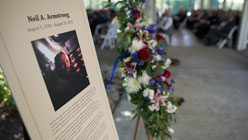To achieve this, it’s important to find an anecdote or quotation that gives a real sense of a person’s voice, said Bernstein. The goal is to pull it together so the reader wishes they had known the person while they were still alive.
Bruce Weber said the goal is to craft a story. “You get rid of the news in an obituary in the first sentence: Someone has died. The rest of your job is to tell the story of the life that was lived in as compelling of a narrative as you can put together.”
2. Nothing is off limits.
Obituaries are distinct from paid death announcements and are meant to cover people’s lives in comprehensive, interesting and accurate ways.
“It’s not a eulogy, it’s not a biography, it’s a news story,” said Powell. “Our job as reporters is not to leave the readers asking questions, but to answer those questions.”
Formerly taboo topics such as suicide and HIV are now mentioned more often, but generally that’s done with the permission of the family or partner of the deceased. Bernstein said another sensitive issue that sometimes comes up at his newspaper is that it includes all of the subject’s marriages.
“We consider obituaries to be part of the news section so there isn’t really anything that is off limits,” Weber said.
3. Obituary writers are like actuaries.
At a large newspaper like the New York Times, up to 1,500 advance obituaries are prepared, filed, and constantly updated in case a public figure dies suddenly. “There’s an actuarial quality to what we do,” Weber joked. “When someone is prominent and gets to be 70 or 75 or 80, it begins to attract our notice.”
Before a newsworthy figure dies, they may be contacted for quotes, information, and background on their lives. The Times has also started making pre-recorded video segments as part of a series called The Last Word, in which the deceased speaks for themselves.
4. Grieving families are usually receptive to interviews.
The appeal of obituaries, according to Bernstein, is that while so much news is ephemeral, obituaries are generally kept.
Powell said she has heard of families who blew up obituary articles to display them on easels at funerals. Others even buried their loved ones with copies of their obituary. A testament to how forthcoming survivors can be, Powell said that even family members of the Ku Klux Klan’s grand dragon were eventually persuaded to do an interview.
5. Social media has helped the living stay connected to the dead.
Obit magazine Managing Editor Krishna Andavolu said people are increasingly using social media to keep memories alive. Remembering the dead becomes an introspective act.
Andavolu said the death of children’s book author Maurice Sendak was especially illuminating about the use of social media.
“My Facebook feed blew up with people saying, R.I.P. Maurice Sendak,” he said. “They’re likening it to an obituary [by] sharing a thought about how that book 'Where the Wild Things Are' influenced their life growing up. Instead of keeping that sentiment to themselves … they were able to perform for their social media circle and say this is a person who is integral to my life.”
Andavolu said people were essentially telling the world: “I’m also saying something about myself.”
